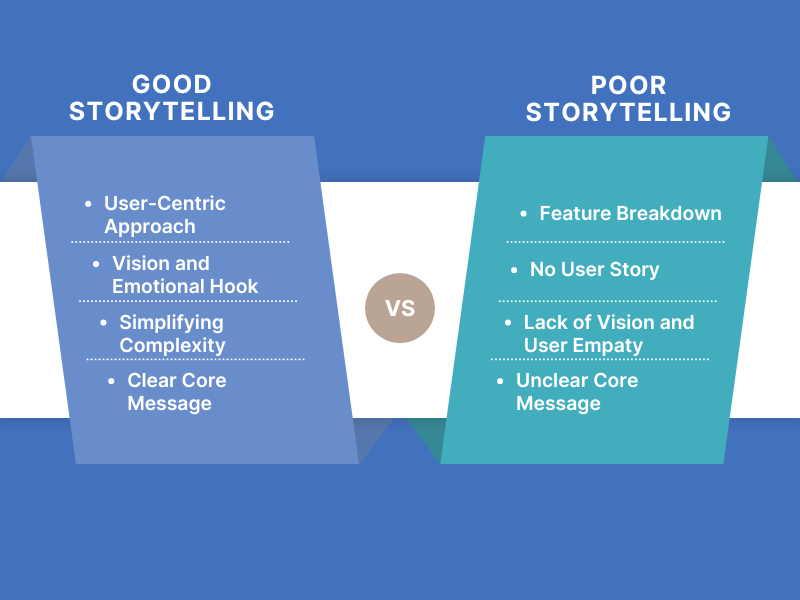Storytelling is a powerful tool that product managers can leverage to communicate vision, inspire teams, and engage customers. Effective storytelling can transform complex product ideas into compelling narratives that resonate with diverse audiences, drive decision-making, and foster a shared understanding of goals and values.
As a product manager, you are often at the intersection of business strategy, design, and technology. One of the most effective ways to navigate this intersection is through storytelling.
Storytelling helps you articulate the vision and purpose of your product and plays a crucial role in aligning stakeholders, motivating teams, and engaging customers.
The Importance of Storytelling in Product Management
A well-crafted story can communicate the product vision clearly and compellingly. It helps stakeholders understand the “why” behind the product, which is essential for gaining their support and commitment.
When stakeholders see the larger picture and the impact the product can have, they are more likely to buy into the project and offer their resources and support.
A shared story also aligns development teams around a common goal. It motivates and inspires the team to work towards the vision, overcoming challenges and setbacks.
When team members are aligned and motivated, they are more productive, innovative, and committed to the success of the product.
Good vs. Poor Storytelling

Let’s say you’re presenting a new fitness app to the executive stakeholders. The app is meant to help users set fitness goals, track their progress, and stay motivated.
Good Storytelling
Begin your presentation with a powerful narrative, having conducted thorough research on your target audience. This allows you to create the user persona that you’ll focus on. Talking about a specific persona or target group allows you to help the audience imagine your presentation as something that addresses the needs of a real person.
“Emily is a busy professional who has struggled to find time for fitness. Despite trying various apps and fitness programs, she has yet to find one that fits her busy schedule and keeps her motivated.
With this app, she could set fitness goals and receive customized workout plans suited to her hectic lifestyle.
However, it’s not solely about the workouts; Emily can also engage with friends, participate in fitness challenges, and share her achievements, which boosts her motivation and involvement.”
Then, present the future vision in a way that inspires and engages stakeholders. Inspiration can transform passive approval into active advocacy, crucial for securing resources and commitment.
“Envision a world where everyone can accomplish their health goals regardless of their schedule or fitness level.
We are not only developing an app but also fostering a community and a motivational tool in one.”
By using simple terms, describe how the app will work. Clear, straightforward explanations help prevent misunderstandings and misinterpretations, ensuring that everyone is on the same page.
“Our app will generate personalized workout plans and monitor user progress using an easy-to-use interface.”
Finally, present the core message in a succinct and impactful way. When the message is clear and focused, it is more likely to be remembered by the audience, making it easier for them to recall and support the product’s vision and goals.
“This fitness app aims to transform lives by making fitness attainable and enjoyable for all.”
Key points to remember:
- A user-centric approach makes the app relatable and demonstrates real-world benefits;
- Presenting a compelling vision and emotional hook can inspire and engage stakeholders;
- Simplifying complexity by explaining the features in simple terms makes the message reach the audience faster;
- A presentation needs a clear and memorable core message;
Poor Storytelling
When presenting your fitness app idea, it’s important to start by providing context, relatable examples, and its benefits before listing its features. This approach is more likely to engage stakeholders and capture their attention.
So, if you only concentrate on the features you plan to implement, you will quickly lose your audience’s attention.
Let’s look at an example of how not to present your idea of your fitness app.
“The app generates personalized workout plans based on user input. Users can log their workouts and track their progress over time. We also have a social feature where users can connect with friends, join fitness challenges, and share their achievements.
The app’s backend utilizes machine learning algorithms to adapt workout plans in real time. It also includes API integrations for social features and uses a cloud-based storage solution for user data.
In conclusion, it provides a comprehensive set of features for fitness tracking and social engagement.”
Key points to remember:
- The lack of relatable examples and real-life context makes it difficult to inspire or emotionally connect with the audience;
- Technical jargon can be overwhelming for a non-technical audience;
- Unclear and uncompelling core message makes the idea less memorable;
When to Use Storytelling?
1. Vision and Strategy Presentations
When presenting the product vision and strategy to stakeholders, a well-told story can make the vision more tangible and inspiring.
It can help stakeholders see the future potential of the product and understand why it is worth investing in.
When you paint a vivid picture of the future, you can inspire confidence and enthusiasm among stakeholders.
2. Team Meetings
In team meetings, stories can be used to illustrate user problems, share success stories, or explain the rationale behind certain decisions, thereby fostering a deeper understanding and connection among team members.
Stories can also be used to celebrate successes and learn from failures, creating a culture of continuous improvement and learning.
3. Customer Engagement
Storytelling is a powerful way to engage customers. Whether it’s through marketing campaigns, user onboarding, or customer support, stories can make your product more relatable and memorable.
Sharing stories of how your product has helped other customers can build trust and credibility with potential customers.
4. Product Launches
During product launches, a compelling story can create excitement and anticipation, making the launch more impactful and successful.
By telling the story of how the product was developed and the problems it solves, you can generate buzz and interest among potential customers and media.
How to Craft a Compelling Story?
1. Know Your Audience
Understanding your audience is the first step in crafting a compelling story. Whether your audience is stakeholders, team members, marketing and sales teams, or customers, tailor your story to their interests, needs, and pain points.
The more you know about your audience, the better you can craft a story that resonates with them and addresses their specific concerns and motivations.
- When communicating with executives and stakeholders, focus on the strategic vision, business impact, and ROI. Use high-level stories highlighting how the product aligns with business goals and delivers value. Executives are often interested in the big picture and the product’s long-term impact, so make sure your story addresses these concerns.
- Focus on user stories and technical details for development teams. Highlight user pain points and how the product addresses them, using detailed examples to show the technical challenges and solutions. Development teams need to understand the technical requirements and implications of the product, so provide them with the information they need to do their job effectively.
- Marketing and sales teams need stories highlighting the product’s unique selling points and benefits. Use customer success stories, testimonials, and case studies to illustrate the product’s impact and advantages. These stories can be used in marketing campaigns, sales pitches, and promotional materials to attract and convert customers.
- For customers, focus on relatable stories that address their needs and pain points. Use simple, engaging narratives that show how your product improves their lives or solves their problems. Customer stories should be easy to understand and resonate with their experiences and expectations.
2. Define the Core Message
Every story should have a clear core message. This is the main point you want your audience to take away. Ensure that your story consistently reinforces this message. A clear and focused message will make your story more impactful and memorable.
When defining your core message, make sure you’re focusing on the benefits your product provides rather than just listing features.
Aim for a message that’s brief and to the point, avoid complex language and make sure that it can be easily understood by anyone.
3. Use a Simple Structure

A good story has a clear beginning, middle, and end.
Start by setting the scene and introducing the characters (e.g., users or stakeholders). These are the users that you are trying to help with your product.
Then, present their problem or challenge, followed by your product’s solution, and conclude with a positive outcome.
This structure makes the story easy to follow and understand.
4. Make It Relatable
Use real-life examples, anecdotes, and analogies to make your story more relatable. This helps your audience connect with the story on a personal level. When people see themselves in the story, they are more likely to engage with and remember it.
5. Use Visuals
Visuals play a crucial role in enhancing storytelling by capturing the audience’s attention and making the story more engaging and memorable.
Incorporating images, diagrams, and videos can effectively illustrate key points and provide visual support for complex concepts, making the story more dynamic and interesting.
Additionally, using mockups and prototypes can further support ideas and facilitate clearer explanations, ultimately enhancing overall understanding and impact.
6. Evoke Emotions
Stories are powerful because they make people feel things. When you tell a story, try to make people feel empathy, excitement, and motivation. Emotional stories are more likely to stick with people and get shared, reaching more people and making a bigger impact.
When you tell a story, focus on the people it’s about. If you’re making a product, think about the people who will use it. Talk about their needs, challenges, and goals.
This will help everyone working on the product to understand and care about the people who will use the product, making sure the product really meets their needs and gives them a good experience.
Storytelling Strategies
1. The Hero’s Journey
The Hero’s Journey is a classic storytelling framework that involves a hero (the user) who goes on an adventure, faces challenges, and ultimately triumphs with the help of a guide (your product). This framework is highly engaging and can be used to illustrate the value of your product in helping users achieve their goals.
2. Problem-Solution-Result
This strategy involves presenting a problem, explaining how your product provides a solution, and showcasing the results. It’s straightforward and effective, especially for explaining complex products.
When you clearly outline the problem and how your product resolves it, you can highlight the value of your product and persuade your audience of its effectiveness.
3. Before-After-Bridge
In this strategy, you describe the situation before your product (Before), explain how your product changes the situation (After), and then describe the benefits and improvements (Bridge).
This method is particularly valuable for marketing and sales, as it allows you to showcase the contrast between the before and after scenarios, highlighting the impact and benefits of your product.
4. Data-Driven Storytelling
Using data to tell a story can add credibility and persuasiveness. Presenting key statistics, user feedback, and case studies in a narrative format can help convince stakeholders of the product’s value.
Data-driven stories are particularly effective in business contexts, where decisions are often based on evidence and analysis.
Conclusion
Storytelling is an essential skill for product managers. It helps in communicating vision, fostering empathy, aligning teams, simplifying complexity, and persuading stakeholders.
Product managers can craft compelling narratives that drive engagement and success by understanding the audience, defining a clear message, and using effective storytelling strategies.
Whether it’s presenting to executives, motivating teams, or engaging customers, storytelling can make your product more relatable, memorable, and impactful.
Incorporate storytelling into your product management practices, and you will see a significant difference in how your product is perceived and adopted. Remember, every product has a story to tell – make sure yours is told well.

